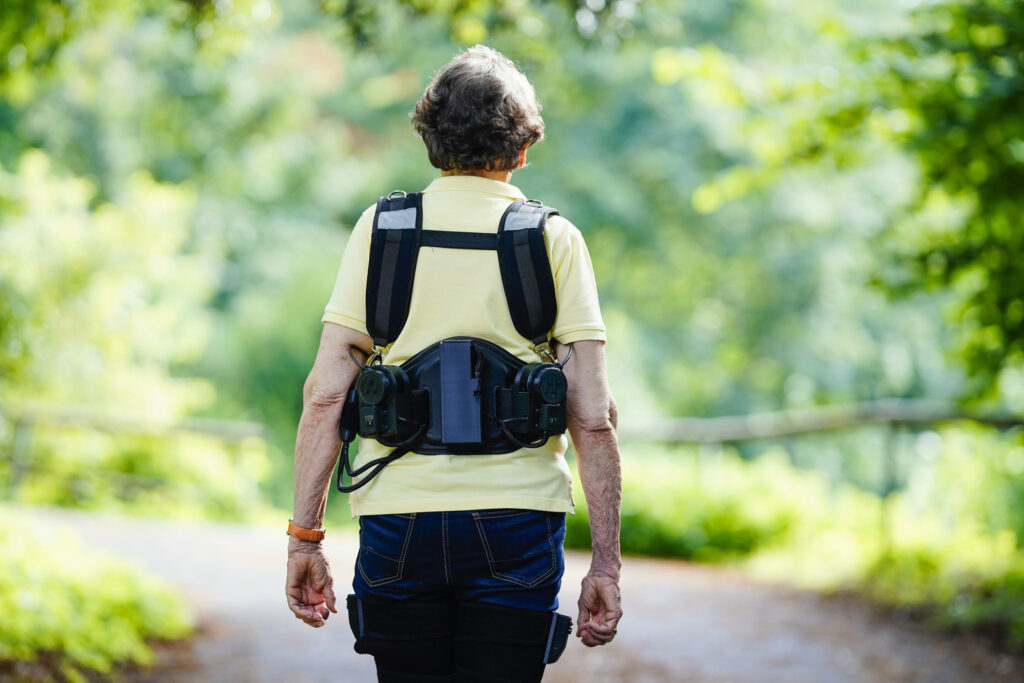Recent technological advances have opened new valuable opportunities for assisting senior adults and individuals with physical disabilities. For instance, they have enabled the development of new interactive systems designed that can assist users with everyday activities, such as eating, reading or practicing their memory.
Researchers at Heidelberg University (now in force at the Technische Universität München–TUM) recently introduced WalkON, a new assistive system that could improve the walking efficiency of older adults and people with limited mobility. This system, presented in a paper published in Nature Machine Intelligence, consists of a pair of soft robotics shorts that can support the flexion of hips while walking.
This project is part of a broader research effort involving two different consortia, namely SMARTAGE and HEIAGE, that focuses on developing digital technology and intelligent assistive systems for older adults.
The WalkOn shorts were developed by post-graduate students under the supervision of Lorenzo Masia, before with Heidelberg University and now a Professor of intelligent bio-robotic systems at Technische Universität München (TUM), Deputy Director of the Munich Institute of Robotics and Machine Intelligence (MIRMI) and lead of the Assistive Robotics and Interactive ExoSuits (ARIES) Lab.
“Our recent paper was inspired by the growing need for solutions to help older adults maintain mobility and independence as they age,” Enrica Tricomi, Ph.D. student at Heidelberg University and first author of the paper, told Tech Xplore.
“Walking becomes more challenging and energetically demanding with age, which can limit a person’s ability to move freely and enjoy daily life. Recognizing the potential of wearable assistive technologies, we set out to design a device that could address these challenges in a practical, everyday setting, not just within controlled laboratory environments.”
The primary objective of the recent work by Tricomi, Masia and their colleagues was to develop a lightweight and soft robotic system that could improve the walking efficiency of older adults in real-world settings. Notably, this device should be clothing-like and unobtrusive, reliably enhancing the mobility of users without limiting their movements.
WalkON, the system developed by the researchers, consists of a pair of soft and lightweight robotic shorts that can support the hip movements required to swing the legs forward while walking. These robotic shorts can simplify walking for frail individuals and people with limited mobility, without being bulky and intrusive.
“We also wanted to test our device in real-world scenarios, assessing its ability to reduce the energy required for walking and how users felt while using it,” said Tricomi. “We tested WalkON in outdoor paths, with young adults hiking uphill and older adults walking on flat ground. The results demonstrated that WalkON significantly reduced the energy needed for walking, allowing participants to move more efficiently while still feeling in full control of their movements.”
In initial tests involving both younger and older adults, the WalkON shorts were found to significantly reduce the energy required by users to walk. Overall, the team’s findings suggest that their system could be a valuable technology for improving mobility in everyday settings.
“In terms of real-world applications, WalkON could be used as a daily assistive device for older adults or individuals with mobility challenges,” explained Tricomi. “It could help improve walking efficiency during routine activities like walking in the park, grocery shopping, or even more physically demanding tasks like hiking. The energy savings provided by WalkON may enhance endurance, allowing users to remain more active, preserve their independence, and maintain a higher quality of life.”
The most notable advantage of the WalkON system is that it can improve mobility without causing any discomfort to users, which could significantly facilitate its widespread adoption. Tricomi, Masia and their colleagues are now planning to build on their research findings to conduct further tests, aimed at assessing their system in more challenging scenarios.
“Our research group, led by Professor Masia, has relocated from Heidelberg to the Technical University of Munich (TUM), where we now have access to the Geriatronics Center in Garmisch-Partenkirchen, which is part of the Munich Institute for Robotics and Machine Intelligence (MIRMI) at TUM and Prof Masia is the Deputy Director with specific scientific responsibility of on the Geriatronics Project,” said Tricomi. “This center is dedicated to developing assistive tools to enhance the quality of life for older adults, and its beautiful surroundings offer ideal outdoor hiking terrain.”
The researchers are now preparing to dispense several WalkON devices to the Geriatronics Center in Germany, where older adults will test them as they take walks on nearby hills or walking up and down flights of stairs. This will allow them to assess their system’s performance across a wider range of environments and mobility tasks.
“In parallel, we are also testing different versions of the robotic shorts designed to support other movements for frail individuals, such as sit-to-stand transfers,” added Tricomi. “This work is being carried out in collaboration with the Bethanien Clinic in Heidelberg. These additional trials aim to expand the application of WalkON to assist with a wider range of mobility challenges, further enhancing its potential to improve daily life for those with limited physical capabilities.”
More information:
Enrica Tricomi et al, Soft robotic shorts improve outdoor walking efficiency in older adults, Nature Machine Intelligence (2024). DOI: 10.1038/s42256-024-00894-8.
© 2024 Science X Network
Citation:
Soft robotic shorts could assist older adults and people with limited mobility while walking (2024, October 24)
retrieved 24 October 2024
from https://techxplore.com/news/2024-10-soft-robotic-shorts-older-adults.html
This document is subject to copyright. Apart from any fair dealing for the purpose of private study or research, no
part may be reproduced without the written permission. The content is provided for information purposes only.
